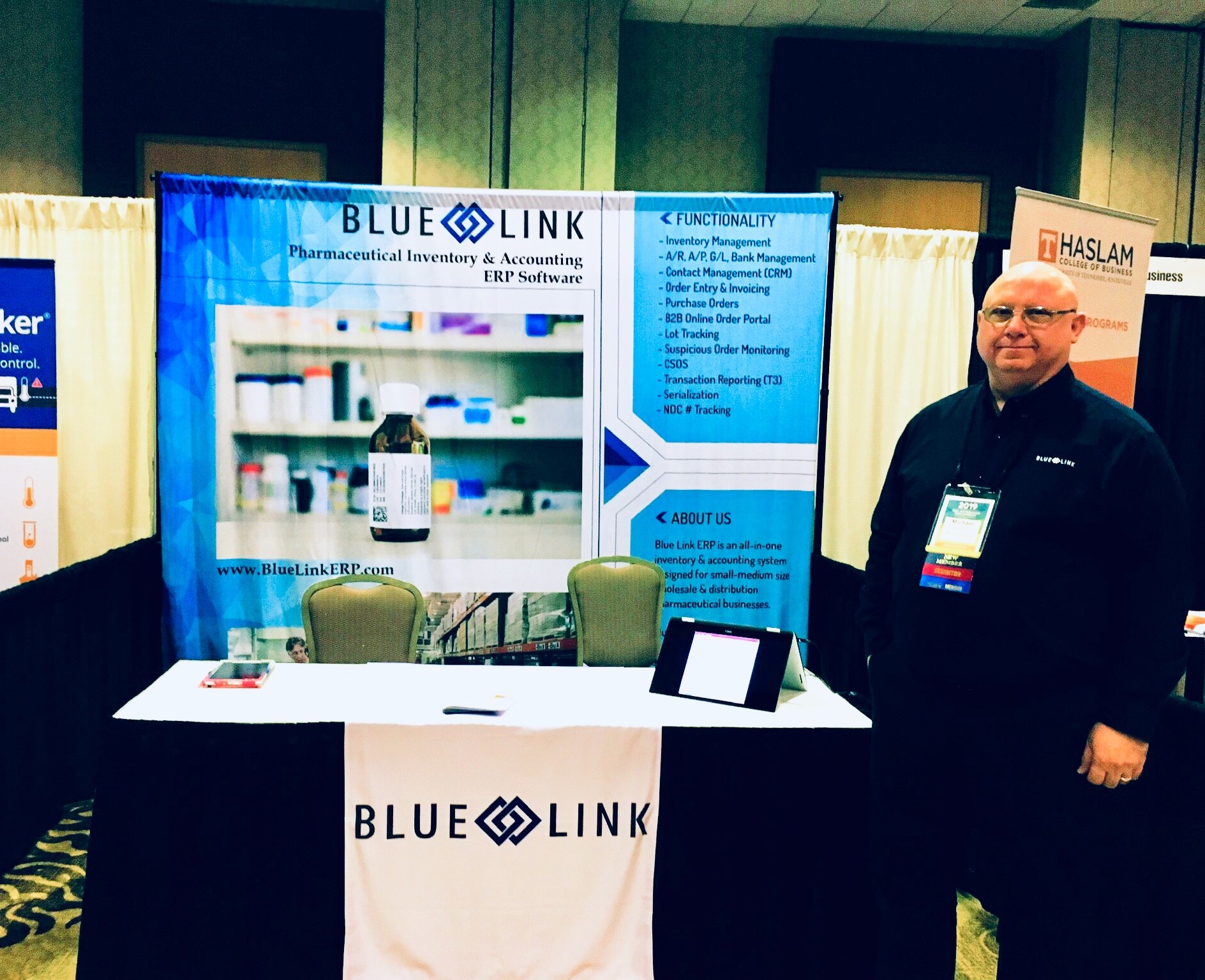Disclaimer: The information and opinions expressed in this blog are based on the author's best understanding of the updates from HDA’s 2019 Distribution Management Conference and Expo and do not necessarily reflect the official policies or opinions of the industry in whole.
Blue Link was excited to once again attend the HDA's Distribution Management Conference and Expo, March 10-13 in beautiful Palm Desert, California. Exhibiting for the first time as an official HDA member, Blue Link had access to numerous networking opportunities and spoke with many pharmaceutical wholesalers and distributors about how to best prepare and manage activities surrounding the impending DSCSA compliance deadline with Blue Link’s pharmaceutical ERP software.
The show was attended by more than 500 industry players and boasted numerous informative sessions and productive roundtable discussions that allowed attendees from all backgrounds (distributors, software providers, 3PLs, manufactures) to share their plans and concerns regarding traceability and getting ready for DSCSA. Other sessions included discussions around specialty pharmaceutical trends, supply chain security, controlled substance regulations, legislative updates and more.
While there was a lot of information shared, the below recap will focus on DSCSA specific updates.
Here are the DSCSA requirements currently in effect in the industry:
- TI/TH/TS
- Trading Partner Requirements (Authorized Trading Partners –ATPs)
- S&I Product Procedures, Investigations and Notifications
- Wholesale Distribution and 3PL Licensure Reporting
- Saleable Returns Verification
- Product Identifier/Serialization
Distributor Requirements Starting November 27, 2019
- Distributors will no longer be able to buy/sell a product unless it has a “product identifier” including 4 data elements; GTIN, Lot #, Serial # and Expiration Date, (unless grandfathered or subject to Waivers Exceptions Exemptions -WEE).
- Saleable Returns – Products returned to a distributor will not be able to be placed back into inventory to be resold unless the unit is “verified” through an approved method of verification (Note: since the release of the this Blog Post, the FDA has delayed the enforcement of this requirement until November 2023)
- If determined that a product is suspect, the “Form FDA 3911” must be filed with the FDA
- Manufacturers and repackagers must respond to saleable returns verification requests within 24 hours
Verification of Saleable Returns
There are over 60 million returned products annually in the pharmaceutical industry. Effective November 27, 2019, products that are in the supply chain that are returned for potential resale, must first be “verified” to ensure the legitimacy of the product before it can be put back into circulation and re-sold. In order to do this, distributors must “verify the product identifier, including the standardized numerical identifier, for each sealed homogeneous case of such product or, if such product is not in a sealed homogeneous case, verify the product identifier, including the standardized numerical identifier, on each package.”
Some of the challenges discussed with the verification of saleable returns are that there is a need for speed and accuracy in terms of turnaround times for approval as some distributors deal with high volumes of returns. Some other issues discussed were:
- Data mismatches/discrepancies
- The timing of development of technology
- Limited FDA guidance
- Can a distributor that receives a returned product, legally “verify” the returned product using only the data they have stored in their system(s)
- Acceptable methods of saleable returns verification
Current Solutions for Saleable Returns (Verification Router Service)
There are a few options for compliance in 2019 for saleable returns verification including EPICS, VRS, Email/Phone, EPICS & VRS. While people are choosing one or a mix of all, there is a large demand for VRS providers such as LSPedia, rxfcel, and Adents. VRS providers enable pharma wholesalers and distributors to verify serialized products with a single scan of 2D barcodes and meet the requirements of GS1 standards. With these types of service solutions, the verification request and response is almost instantaneous.
If a wholesaler opts for the more manual approach, they can communicate directly with the manufacturer, provide the applicable information and once the verification is requested, the manufacturer is required to respond to these requests within 24 hours.
The issue of being able to “verify” a returned product using only the data stored in a distributor's system was discussed during one of the sessions. Although it was not 100% confirmed legally, the consensus to be able to use stored data to verify a returned product was the following:
- Product MUST be purchased directly from the manufacturer/repackager
- Product elements “GTIN, Lot#, Serial #, Expiration Date” MUST be received electronically into the system, NO secondary service provider information is acceptable
What this means to the industry, is only those distributors that are buying directly from the manufacturer/repackager can verify any returns using the data they are storing in their systems. If a distributor is purchasing from another distributor in the supply chain, their data (although it might be accurate) IS NOT viable data to use for “Saleable Returns Verification”.
As a leader in the pharmaceutical ERP space, our goal is to help our customers meet these requirements by providing advanced functionality such as VRS connectors (powered by LSPedia) as part of its all-in-one pharmaceutical ERP solution, at an affordable price. Our full suite of pharmaceutical functionality can be found at the end of this post.
Grandfathered Product
There are currently non-serialized and serialized products in the market. Only about 35% of returns will have serialization as of November 2019. As a result of products with very long expiration dates, that were packaged prior to the November 2018 deadline, the FDA has implemented “Grandfathering” of such products.
If a product doesn't have a 2D barcode accompanied by the 4 data elements, this product will not meet the requirement by the DSCSA and after the November 2019 deadline, will no longer be able to be sold or received unless the product has been deemed as “Grandfathered”. As it appears there will be many of these products still in the supply chain in November 2019. Blue Link raised the question in one of the sessions if there was a “list” of Grandfathered products. After a short giggle, the answer was "NO, not at this time".
Product Identification at the “Smallest Saleable Unit”
The DSCSA required that as of November 2018, Manufacturers and Repackagers apply serial numbers to what they deem to be the “smallest saleable unit”. During a round table session, it was discussed that to some distributors, the smallest saleable unit is often the individual units within a case that are sold separately and may no longer be sold at this individual unit level. It is strongly suggested that if you are a distributor that has in the past purchased by the case and sold individual units from that case to your clients, you must ensure that each unit level of product you are selling will have a serialized number in November. If not, you may have to re-think how you are going to sell this product.
Is the Industry Ready?
The general feel of the conference was that although significant work has been done by the industry to prepare for and meet upcoming DSCSA requirements, there is still a lot more to do. The marketplace is ready but the biggest challenge is around the management of serialized and non-serialized product. Adoption, collaboration and bringing key stakeholders to meet these requirements is a significant challenge.
With our all-in-one Pharmaceutical ERP solution, Blue Link strives to help and support our pharmaceutical customers through these challenges and better manage these requirements to meet compliance and ultimately help keep the pharmaceutical market safe. We will continue to review new FDA Guidance and attend future conferences such as the HDA Distribution Management Conference and Expo and HDA Traceability Conference to ensure our Blue Link Pharmaceutical ERP software continues to provide the functionality needed by the industry to comply with requirements set out by the DSCSA.
Blue Link’s current functionality includes:
- Sophisticated product tracking to meet industry standards/regulations
- DEA and State License Expiry Date Management
- Transaction History Management
- Automatic printing and emailing of T3 reports
- Integrated VRS for Saleable Returns Management
- Integrated Drummond Certified CSOS and ERP sold as one system (the first of its kind!)
- Secure B2B Online Ordering Portal for convenient online ordering (including Controlled Products)
- Integration to 3rd party applications such as TrXade
- Business process functionality such as inventory management, warehouse management, and robust accounting features
If you have questions, please email our Pharmaceutical ERP Software expert:











